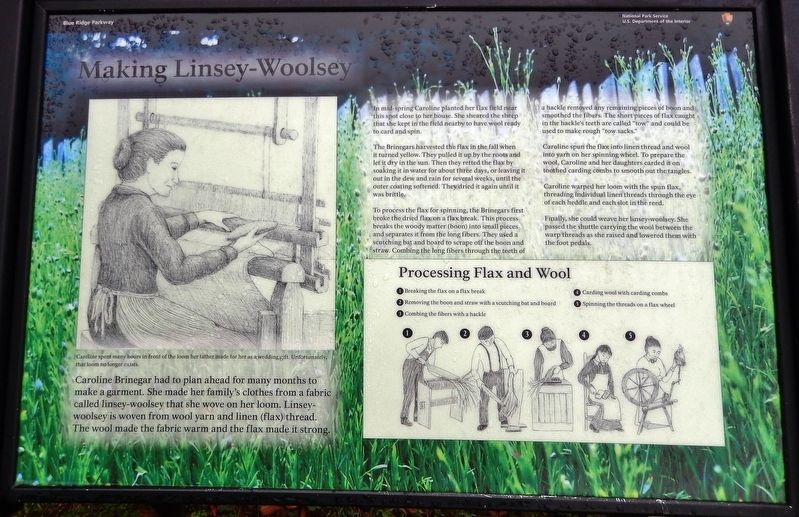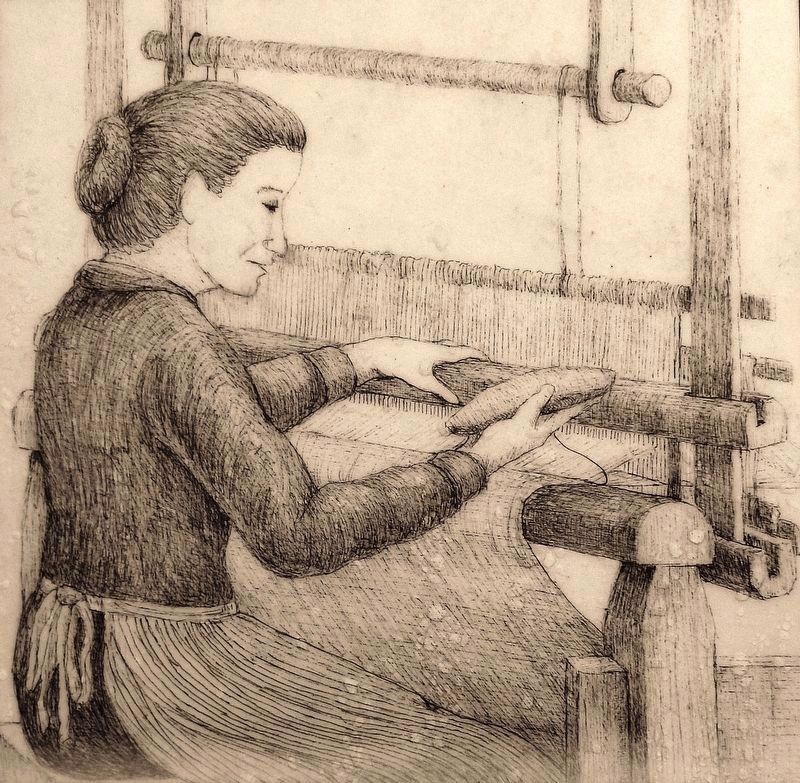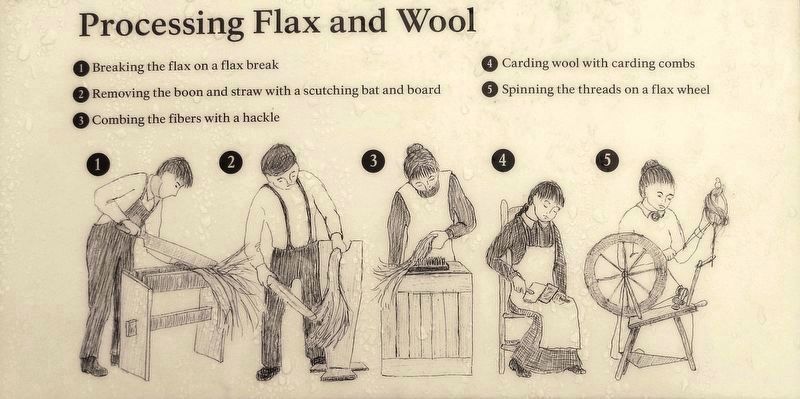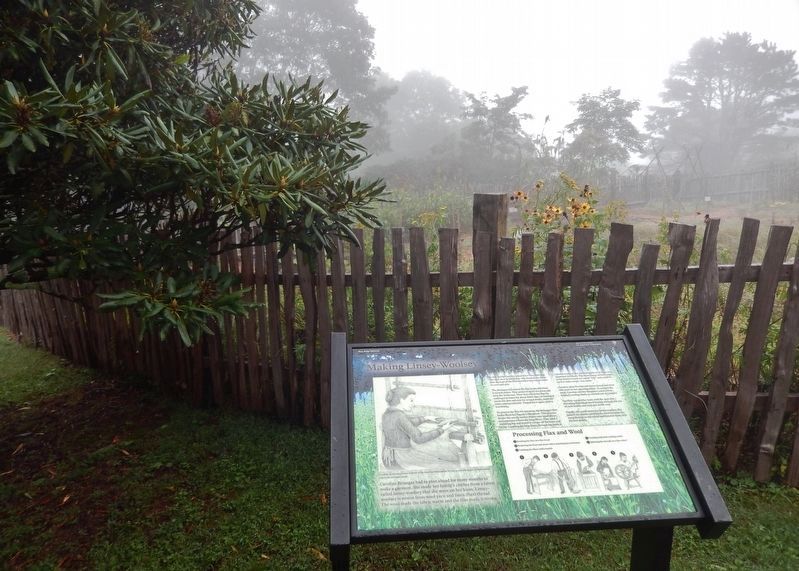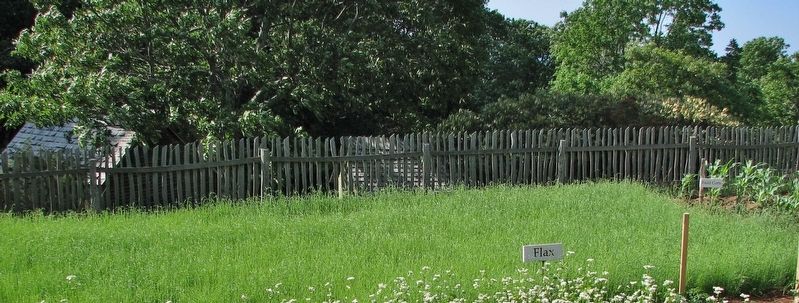Near Traphill in Wilkes County, North Carolina — The American South (South Atlantic)
Making Linsey-Woolsey
— Blue Ridge Parkway —
In mid-spring Caroline planted her flax field near his spot close to her house. She sheared the sheep that she kept in the field nearby to have wool ready to card and spin.
The Brinegars harvested the flax in the fall when it turned yellow. They pulled it up by the roots and let it dry in the sun. Then they retted the flax by soaking it in water for about three days, or leaving it out in the dew and rain for several weeks, until the outer coating softened. They dried it again until it was brittle.
To process the flax for spinning, the Brinegars first broke the dried flax on a flax break. This process breaks the woody matter (boon) into small pieces and separates it from the long fibers. They used a scutching bat and board to scrape off the boon and straw. Combing the long fibers through the teeth of a hackle removed any remaining pieces of boon and smoothed the fibers. The short pieces of flax caught in the hackle's teeth are called "tow" and could be used to make rough "tow sacks."
Caroline spun the flax into linen thread and wool into yarn on her spinning wheel. To prepare the wool, Caroline and her daughters carded it on toothed carding combs to smooth out the tangles.
Caroline warped her loom with the spun flax, threading individual linen threads through the eye of each heddle and each slot in the reed.
Finally, she could weave her linsey-woolsey. She passed the shuttle carrying the wool between the warp threads as she raised and lowered them with the foot pedals.
Erected by National Park Service, U.S. Department of the Interior.
Topics and series. This historical marker is listed in these topic lists: Agriculture • Industry & Commerce • Settlements & Settlers • Women. In addition, it is included in the Blue Ridge Parkway series list.
Location. 36° 25.137′ N, 81° 8.757′ W. Marker is near Traphill, North Carolina, in Wilkes County. Marker is on Blue Ridge Parkway (at milepost 239), on the left when traveling south. Marker is located at the Brinegar Cabin pull-out, along the path leading to the cabin, overlooking the garden. Touch for map. Marker is in this post office area: Traphill NC 28685, United States of America. Touch for directions.
Other nearby markers. At least 8 other markers are within 2 miles of this marker, measured as the crow flies. Brinegar Cabin (a few steps from this marker); A Mountain Home (a few steps from this marker); The Brinegar Family (a few steps from this marker); An Outdoor Pantry (within shouting distance of this marker); Making Shoes (within shouting distance of this marker); Mountain Spring (within shouting distance of this marker); Tillers of the Land - Then and Now (approx. 1˝ miles away); Robert Lee Doughton (approx. 1.8 miles away). Touch for a list and map of all markers in Traphill.
Also see . . . Linsey-woolsey. Linsey-woolsey (also called woolsey-linsey) originally referred to a textile made with a flax warp and a wool (worsted) weft. Later it came to mean a material of coarse, inferior wool (weft), woven with a cotton warp. The name linsey is associated with the Suffolk (UK) town of Linsey, where this type of cloth was woven. (Submitted on September 17, 2018, by Cosmos Mariner of Cape Canaveral, Florida.)
Credits. This page was last revised on December 14, 2020. It was originally submitted on September 15, 2018, by Cosmos Mariner of Cape Canaveral, Florida. This page has been viewed 935 times since then and 120 times this year. Last updated on December 8, 2020, by Craig Doda of Napoleon, Ohio. Photos: 1, 2, 3, 4, 5. submitted on September 17, 2018, by Cosmos Mariner of Cape Canaveral, Florida. • J. Makali Bruton was the editor who published this page.
